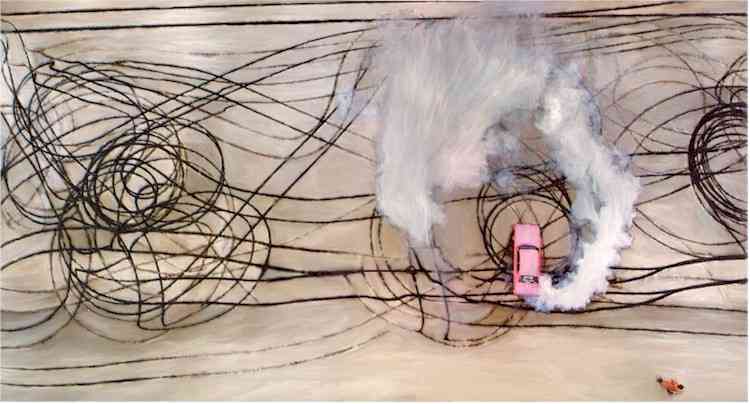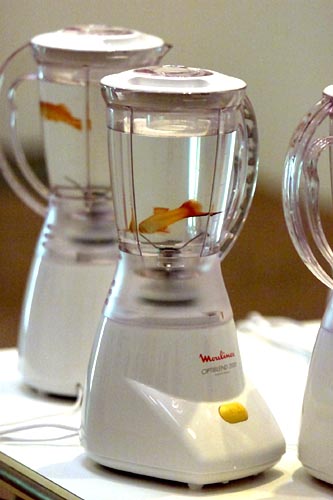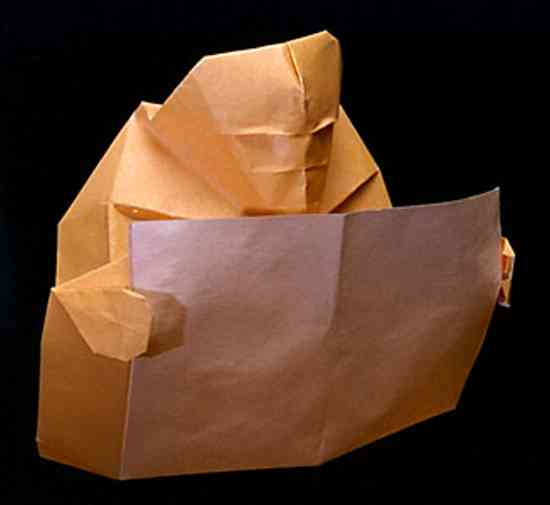Unexpected Sensations
Senses and ScienceArt is science made clear. - Wilson Mizner After a certain high level of technical skill is achieved, science and art tend to coalesce - Albert Einstein Eyes, Ears and ScienceTwo artists have succeeded in involving two or more senses to produce something special. Most of us are likely to approach new art in ignorance of current aesthetic theories and trends and of the artist's previous output, in the hope that it will speak to us or at least grip our attention. Statistically, this hope is likely to be forlorn - innovative artists with an ability immediately to communicate beyond the cognoscentiare a minority in any generation. It's surprising and rewarding, therefore, to encounter artists working in unconventional media who make one sit up and take notice. Two such artists are Carsten Nicolai, based in East Berlin, and the Danish artist Ann Lislegaard, who have recently exhibited at the Museum of Modern Art in Oxford, UK, and have also exhibited widely in the United States and elsewhere in Europe. The Oxford exhibition focused on works combining sound and vision, and these two artists made an impact for reasons associated with science. Lislegaard's "In Another Room" consists of a large white wall towards which is pointed a 500 watt white halogen light. A recording of two people - a man moving around in a room, a woman describing his actions - plays softly in the background. The light illuminates the wall with a rapidly varying intensity proportional to that of the sound. This leads to an effect that challenges one's sense of orientation. Whatever the neural mechanisms at work, contemplating the wall for several minutes produces sensations that are unexpected and memorable. The interest in Nicolai's Atem is less perceptual - it is directly related to known physics - but is still striking and even beautiful. A raised wooden floor has eight large speakers embedded in it, all sounding quietly at slightly different low frequencies - a few hertz - generating both an audible and vibrational effect on the onlooker. The frequencies are shifted slowly, and the envelope of sound amounts to a gradually changing pattern of pulsation, only just discernible as such. But Nicolai places two large glass flasks on the floor, illuminated at an angle by a spotlight. The floor's motion is picked up by water in the flasks, which refract the light onto the floor in a pattern affected by the water waves set up by the vibrations. As the audible frequencies shift, the patterns of light exhibit slowly changing networks of cusps of illumination similar to, but much more fascinating than, those sometimes seen on a swimming-pool floor in bright sunlight. Again, the cumulative effect, drawing on 3 of the senses, is more than the sum of the parts, each of which is striking in itself. These works deserve wide exposure, and could in principle be easily replicated in galleries and science museums. But are they works of art or sophisticated, science-based entertainment? That question is left as an exercise for the reader, best answered only after experiencing them. Source: Nature Vol 404 23 March 2000
Chaotic, QuixoticQuantum Cloud
Anthony Gormley's sculpture was created using, among other things, chaos theory Source: Nature Vol 406 13 July 2000
Jellyfish ArtThis Is Only the Beginningby Chuck Shepherd Great Art! - We've reported on scientists who borrow the jellyfish's "green protein" for medically productive genetic modifications, but Chicago artist Eduardo Kac created controversy recently by proposing to create embryos with the jellyfish's green-light-producing gene just to make visually appealing organisms, such as a glowing rabbit. (Kac's major work so far is Genesis, a sentence from the Old Testament, translated into Morse Code, transposed onto DNA, inserted into fluorescent bacteria, and lit up when anyone accesses the piece on Kac's web site.) In a summer contract with the city of Montreal, artist Devora Neumark performed The Art of Conversation, which consisted of her standing at the entrance to a subway station from noon to 4pm every Tuesday and "conducting spontaneous interchange with interested parties on a variety of topics." Source: Funny Times January 2001 "News of the Weird"
Just Skidding
Clint Ogilvy burns rubber in his pink XU1 Holden Torana to put the finishing "brush strokes" to Source: The Evening Post Tuesday 20 March 2001; photo Reuters For more works of art, see also:
Spies SingRussian Spies on CDby Giles Whittell and Alice Lagnado Russia's spies are celebrating 80 years of the world's second-oldest profession with the covert release of their own CD. In what appears to be the world's first professional recording of songs by spies, about spies and for spies, the lonely glamour of black ops and foreign stakeouts is extolled in a collection of 22 tracks on Their Work is Tough, They Call It Spying. It is being distributed to survivors of the KGB and its successor organisations. Spy's Motto, track No 1, includes the chorus: "As long as spies shall live/ The country will survive." Other tracks include From Kabul to Washington (an elegy on the long reach of Soviet foreign intelligence), Soldiers of the Invisible Front, Spies of the Motherland, and There Goes Your Friend on a Mission. The Work of the Spy is about the perils of Cold War chicanery. "Sometimes we drank with the enemy," growls a baritone, "Or took a bullet from a friend. But that friend was not to blame." Another warns prospective secret agents. "You will always have a role. But never an ovation." The album is not for sale. It is being sent to intelligence bosses and veterans of the KGB and its foreign arm, the SVR, to mark the 80th anniversary of the founding of Soviet intelligence. The cover depicts a spy from the neck down, in 84 standard grey-blue Soviet suit emblazoned with the dagger and star of the KGB. It also features the more recent insignia of Rosinformcentr, an information agency that publicises the Kremlin's Chechnya policies. Rosinformcentr has denied all knowledge of the album, but a copy was obtained through the traditional Christmas sweetener of a bottle of cognac. British traitor George Blake, who escaped from prison in 1966, five years after being convicted as a Soviet spy, said from his dacha outside Moscow that he had not yet received a copy. He preferred Bach, but added: "I suppose the work of foreign intelligence never stops, in peace or war." - The Australian Source: The Dominion Wednesday 3 January 2001
Spies to Publish CookbookGerman special agents have published a cookbook of secret recipes. Top Secret - Schnitzel for Spies is a new book by the Bundesnachrichtendienst (BND) - the German equivalent of MI6. More than two dozen exotic recipes are included in the book, gathered from German special agents stationed around the world. Each recipe is spiced up with anecdotes from the agents about how they have made use of their culinary skills. The stories include advice to a German security chief from a Nigerian counterpart on how to tackle black magic attacks. Another contributor claims an operation in the desert had to be cancelled when a spy camera designed to withstand extreme heat and dry conditions fell into a pot of Turkish honey. The dishes range from a cheese and beer paste on thick black bread, to a vegetable and fish stew from central Africa known as Dongo Dongo. An agent in Scotland offered a recipe for filled sheep stomach, while a mole inside Israel suggested a super spicy fish and pepper soup made with a Nigerian herb that is so strong that it kills the taste buds for several hours afterwards. The cookbook is part off a plan to sell a range of BND merchandise for lovers of espionage who want to feel like James Bond. The line will include Y-fronts with the words Top Secret, Keep Contents Private and even Only for Authorised Personnel stamped on the front. There will also be T-shirts, scarves, ties and blouses. Source: ananova.com Wednesday 22 January 2003
Art Director Cleared over Goldfish in Blenders Exhibit
The installation showing live fish in blenders A museum director has been cleared of animal cruelty after a court ruled a display with goldfish in blenders that visitors could turn on was not cruel. Peter Meyer, director of the Trapholt Art Museum in Kolding, Denmark, drew international notoriety in February 2000 after the exhibit was dubbed cruelty to animals. The display's 10 blenders were plugged in and visitors were invited, if they wanted, to blend the fish. One person did and two goldfish died. Animal rights activists complained and the blenders were unplugged, but the exhibit continued. Danish police fined Meyer the equivalent of £200 for animal cruelty but when he refused to pay, the case went to court. Judge Preben Bagger ruled Meyer didn't have to pay the fine because the fish were killed instantly and humanely. During the two-day trial, experts including a zoologist and a representative of the blender manufacturer, Moulinex, said the fish probably died within a second after the blender started. The installation was the work of Chilean-born Danish artist Marco Evaristti. The temporary exhibit also included a nude picture of the artist with blackened eyes and a bazooka missile surrounded by tubes of lipstick. Source: ananova.com Monday 19 May 2003 © Associated Press photo credit Associated Press
First, the fish aren't goldfish, they're swordtails. Let me get this straight - a quick death is all that's important? A frivolous death means nothing? See also:
Origami, the Art of Paper Folding
Man reading a newspaper Source: allhatnocattle.net See also:
For more on the unusual: events, abilities, means of self-expression, houses, conditions, people, luck, narrow escapes, resemblances, facts, diversions, heroism and more - click the "Up" button below to
take you to the Index page of Contents for this Odds and Oddities section. |
 Animals
Animals Animation
Animation Art of Playing Cards
Art of Playing Cards Drugs
Drugs Education
Education Environment
Environment Flying
Flying History
History Humour
Humour Immigration
Immigration Info/Tech
Info/Tech Intellectual/Entertaining
Intellectual/Entertaining Lifestyles
Lifestyles Men
Men Money/Politics/Law
Money/Politics/Law New Jersey
New Jersey Odds and Oddities
Odds and Oddities Older & Under
Older & Under Photography
Photography Prisons
Prisons Relationships
Relationships Science
Science Social/Cultural
Social/Cultural Terrorism
Terrorism Wellington
Wellington Working
Working Zero Return Investment
Zero Return Investment


